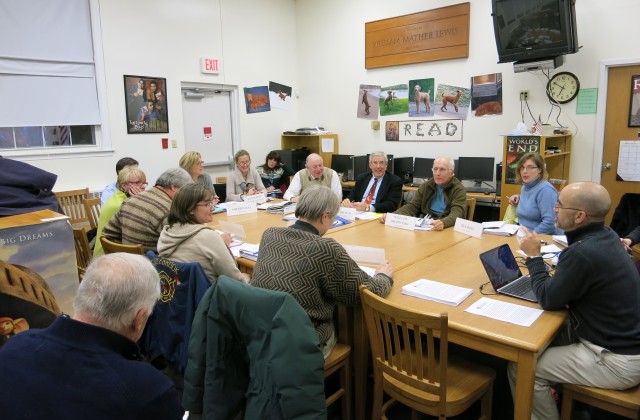Work on Regionalization Study Advances
Botelle Building Judged Big Enough for Both Towns
By Wiley Wood
As members of the citizens’ group studying regionalization examined the floor plan of the Botelle School during a public meeting in mid-December, they quickly reached the conclusion that there would be enough room in the building for all Norfolk and Colebrook primary-schoolers.
The combined enrollment for grades K through 6 in the two towns hovers at 200 students this year, down from 250 in 2006. Noting that the upper capacity of the building is more than 300 students, Bill Brodnitzki, a committee member, said: “Two hundred kids in this space is luxurious.” Including a pre-K of 14, there are presently 117 students at Botelle.
Although consolidation, if it happens at all, is not expected to start before 2015-2016 and enrollment may have declined further by then, the study group estimates that 15 classrooms will be necessary for the new school, counting two rooms for every grade level from kindergarten to sixth grade and another room for pre-K.
Botelle School Superintendant George Counter cautioned that the group would have to contend with the “who’s-going-to-be-out-in-the-hallway issue.” In one scenario, the music room, computer lab and science room would all be turned into classrooms. Music instruction, both vocal and instrumental, would be moved to the Hall of Flags. Laptops and tablets will be provided for Botelle students next year anyway, making the computer lab unnecessary. And science instruction will occur in the homeroom. “We like science, we’re going to have science, we’re not going to have a dedicated room for it,” said Counter.
Sherri Gray, head of the group’s Facilities and Transportation Subcommittee, pointed out that the school might feel a little squeezed at the beginning, but that by year 5 of consolidation every grade level would not need two classrooms.
Summing up for the subcommittee, Brodnitzki said, “I think we can at least report back to the full committee that there’s room here [in the Botelle building] without significant renovation.”
The Norfolk Colebrook Regionalization Study Group, formed in the wake of referendums in both towns in December 2012, has a mandate to study the feasibility of combining the towns’ primary schools. It began its work by drawing up an educational curriculum for the combined school, a task made easier by the similarity of the existing schools’ curriculums.
An often-stated goal among the planners is to use the resource sharing of the two towns to create a better school than either could have independently. According to Counter, the message that will go out to the towns is: “Every program you have now is going to be in the new school, plus there are going to be additional ones in other areas.”
After its work on the curriculum, the study group broke up into subcommittees. The Finance Subcommittee is putting together the educational plan with enrollment and staffing projections to estimate costs for the new school. A five-year budget must be presented to the State Board of Education for approval.
The Facilities and Transportation Subcommittee, after working out how to house the proposed school in the existing building, will examine bus routes.
The thorniest issues have gone to the Governance and Legal Subcommittee, which, under the chairmanship of Julia Scharnberg, has already developed a proposal for the composition and structure of the new regional board. It will have eight members, divided equally between Norfolk and Colebrook. Their votes will be weighted in proportion to the relative populations of the towns (Norfolk: 1787; Colebrook: 1520), and a quorum of 6 will be needed for regular meetings.
Still ahead, Scharnberg’s subcommittee will address the extent and nature of each town’s capital contribution to the new regional school district.
“All the other subcommittees will likely be done with their work before the governance and legal issues are settled,” said one of the participants, “so the whole group can address those questions as a committee of the whole.”
The study group’s plan must be approved by the State Board of Education and ratified by the voters in both towns before a new regional school district can be formed.

